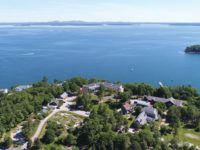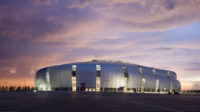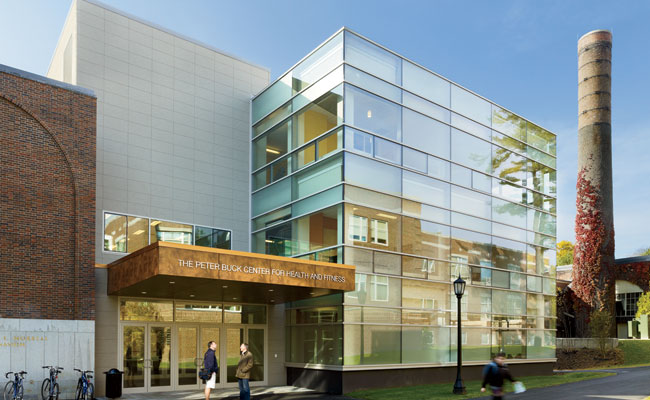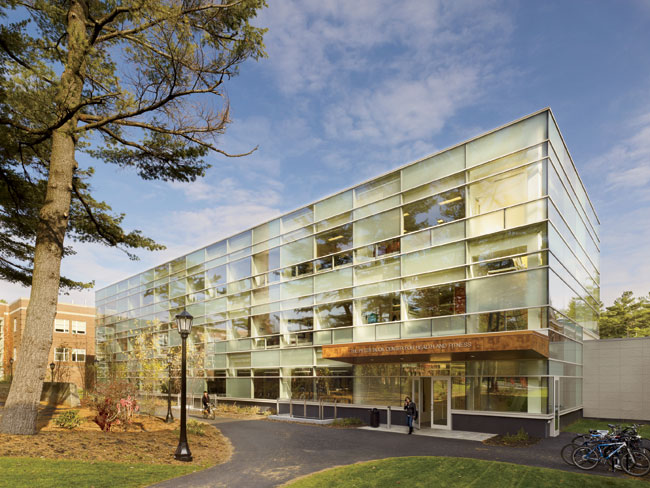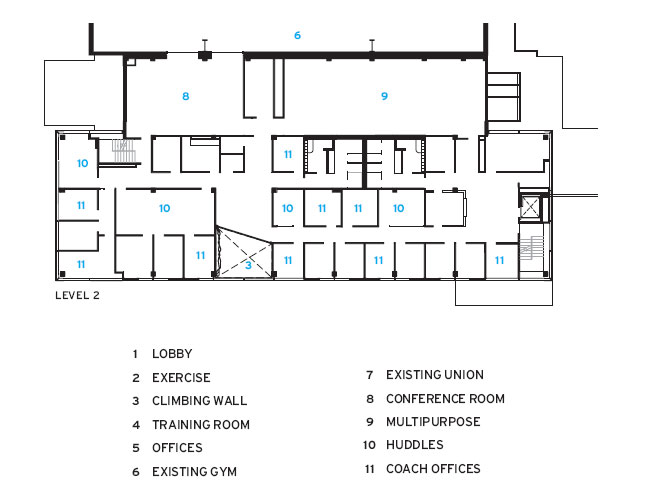Peter Buck Center for Health and Fitness, Bowdoin College
Cambridge Seven creates an ethereal extension for exercise on a traditional campus.




















Architects & Firms
Brunswick, Maine
Bowdoin College in Brunswick, Maine, has one of the few consistently picturesque New England campuses where brick-and-stone 19th-and-20th-century Federal, Classical Revival, and Gothic Revival structures are clustered around a large, tree-lined quad. You can walk from one end of the campus to the other without getting depressed by aggressively substandard Modern architecture built after World War II — as is too frequently the case elsewhere. Only one oversize eyesore (a tower) sits at the edge of the campus, but removed enough not to destroy the gestalt.
Considering what the small, 1,700-student college has at stake, it is not surprising Bowdoin trustees get a bit apprehensive if an architect says something like, “I see an all-glass building here.” As Timothy Mansfield, AIA, a partner at Cambridge Seven, puts it, “They immediately think of a commercial office building on a highway.”
Fortunately, his long-standing firm, established in Harvard’s Modernist heyday (1962) by Peter and Ivan Chermayeff, Thomas Geismar, and four other partners in Cambridge, is trying to integrate the Modern with the historic. At Bowdoin, Cambridge Seven and firms such as Machado & Silvetti [Record, February 2008, page 120] have introduced glass and metal successfully into a campus made sacrosanct by buildings designed by McKim, Mead & White and by Henry Vaughn, not to mention the granite, Romanesque Revival Bowdoin Chapel (1844—55) by Richard Upjohn.
Program
When the school needed to expand Morrell Gymnasium (1965), a brick-walled structure with Soanian blank arches designed by Hugh Stubbins, it turned to Cambridge Seven. Previously the firm had adeptly added the Modernist, glass-and-brick Kanbar Hall (2005) at the northern edge of the campus, and earlier, in 1999, had renovated and expanded Vaughn’s Gothic-style brick Searles Hall (1894).
While the Stubbins gym sits on the periphery of the quad, it is very much a part of the campus — and not on the outskirts by the arena and playing fields. In addition to refurbishing the old gym, the college needed a new fitness space, along with offices for the athletic coaches, an infirmary and medical rooms, plus spaces for yoga and meditation. All of this would be placed in a 44,659-square-foot building, the new Peter Buck Center for Health and Fitness.
Solution
The almost 1-acre site was tight, so the architects removed about one third (15,200 square feet) of the existing gym to create a lanternlike glass-and-steel-frame structure, with a footprint of 13,250 square feet. The 160-foot-5-inch-long rectangular bar is edged on the east by a 135-foot-long, 24-foot-wide spine that functions as the lobby and exhibition space between the existing gym and the new structure. Cambridge Seven raised the main exercise room slightly above grade, and inserted three light wells on the western edge of the lower exercise floor to prevent its having that dark, palace-basement feeling. On the exterior, cementitious panels resembling slate cover poured-concrete foundations and create a plinth that appears to recede under a floating glass box.
The architects installed a curtain-wall system that features three types of glass: clear panels alternating with two gradients of translucent glass formed by varying the pressure during the sandblasting. The limpid, reflective skin wraps around the west and the north elevations, mirroring pines and nearby structures in its glossy surfaces. The glazing pattern of transparency and translucency mitigates glare and provides both view and a sense of privacy for those occupying the different levels within.
The carefully detailed curtain wall has no spandrel panels — just a horizontal mullion aligned with the floor plate — to prevent the appearance of a dark band at each level. The architects stepped back the fascias of the ceiling plenums to make the glass skin seem more unified. Since the gypsum pockets are set away from the glass, the floor plates look transparent all the way up. In addition, the widths of the glass panels vary in a regular rhythm of a 3-foot height on the lowest portion (where the vents are), followed by 5-foot-high and 2-foot-high panels that extend to the 10-foot-high ceiling. Another 4-foot-high panel completes the 14-foot, floor-to-floor height.
While most of the offices average 100 square feet — smaller than the offices in the former quarters — the architects have included “huddles,” or conference rooms, on the interior of the floors for informal meetings. Other strategies — such as the use of recycled materials, the reliance on building products with low-volatile organic compounds, the inclusion of fluorescent lighting, and the installation of a highly reflective roof membrane — got the building awarded a LEED Silver rating.
Commentary
The amount of daylight and the generous views that enter the Buck Center create a bright, pleasant atmosphere. Daylight also helps mitigate the effect of overhead fluorescent lighting, which, however virtuously “green” it may be, too often creates a harsh and cold ambience.
The clear organization of plan and circulation enhances the combined functions of the building, where the heavy-duty grunt work (exercise) takes place on two lower levels, and the most contemplative or quiet activities (yoga and meditation) have their own space on the top floor. As important is the fact that these spaces come with views of the surrounding campus. From the exerior, the center’s glass skin attracts the most attention, and well it should. Sitting among the halls of ivy, Buck Center’s ethereal surfaces reflect its leafy, traditional environs memorably.
Total construction cost: $11,800,000
Gross square footage: 44,659 sq.ft.
Completion date: September 2009
Architect:
Cambridge Seven Associates, Inc.
1050 Massachusetts Avenue
Cambridge, MA 02138
T: (617) 492-7000
F: (617) 492-7007
www.c7a.com
People
Owner
Architect
Personnel in architect's firm who should receive special credit:
Interior designer
Engineer(s): Structural Engineer: Goldstein-Milano, LLC, Reading, MA.
Consultant(s) Lighting: Boston Light Source, Boston, MA. Acoustical: Acentech Inc., Cambridge, MA. Other: LEED consultant: Fore Solutions, Portland, ME.
General contractor:
Photographer(s):
Kwesi B. Arthur, Cambridge Seven Associates
CAD system, project management, or other software used: |
Products
Structural system
Exterior cladding Rainscreen (terra cotta, composite, etc.): Nichiha fiber cement panels. EIFS, ACM, or other: Foundation cladding: Petrarch composite panels. Moisture barrier: W.R.Grace Permabarrier
Other cladding unique to this project:
Roofing
Windows
Glazing Skylights: Wasco. Other: Fire rated glazing system (at climbing wall):Technical Glass Products.
Doors Metal doors: and hollow metal frames: Curries Co. Wood doors: Marshfield DoorSystems.
Hardware Closers: LCN Exit devices: Sargent Pulls: Rockwood
Interior finishes Suspension grid: by ceiling mfr. Cabinetwork and custom woodwork: Cyrus Chilton Millwork, Biddeford, ME Paints and stains: Sherwin-Williams Plastic laminate: (cubbies & cabinets) WilsonArt, Lamitech Solid surfacing: (countertops) DuPont Corian
Floor and wall tile: Bathroom floor tile: Daltile Veranda Bathroom wall tile: Royal Mosa 15 Thirty Greys Shower floor tile: Daltile Keystones Resilient flooring: Noraplan Environcare Carpet: C&A Tanka (carpet tiles) Raised flooring: Wood athletic flooring (multipurpose/yoga room, meditation room): Horner SAFE panel system.
Special interior finishes unique to this project: Resilient athletic flooring (free weights, multipurpose): Mondo Sport Impact Face brick (lobby): Glen-Gery Olde Detroit Roller shades: MechoShade Eurovail and Equinox Entrance mats: Nuway Tuftiguard
Furnishings Reception furniture: National Swift (waiting/lounge seating and tables) Chairs: Encore Chance (side chairs), Encore Saga (desk chairs) Tables: (see reception furniture above)
Lighting Downlights: Prescolite Architektur (CFL lamping) Exterior: College standard walkway light: King post top luminaire, Spring City post. High Intensity Lighting at climbing wall: Insight Taos SR922 250w MH Track Lighting at climbing wall, skylight: Prescolite Architrak w/MR-16 heads Dimming System or other lighting controls: Integrated lighting control with daylight harvesting: Lighting Control & Design, Glendale, CA
Conveyance
Accessibility provision (lifts, ramping, etc.):
Plumbing
Energy |


